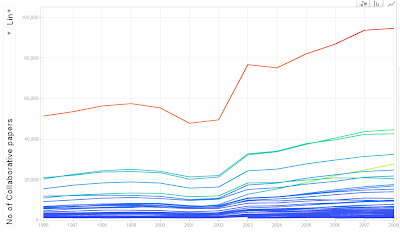The latest issue of Nature has a feature on Educating India [thankfully, not paywalled!]. Written by Anjali Nayar, it covers the major points (including the employability issue that Geeta Anand focused on), weaving in sound-bites from Kapil Sibal, C.N.R. Rao, T. Ramasami, and others.
A fairly big part of the article is devoted to discussing the level of corruption in many colleges:
Rahul's parents paid hundreds of thousands of rupees up front to get him into the institute after he scored poorly on entrance exams. He says that about 30% of his peers entered in the same way, and at other colleges the informal 'management quota' can be as high as 40–50%.
This year, tuition at the institute cost 85,000 rupees (US$1,900): more than three times that charged by the IIT system. And the payments at many private colleges don't stop there, says Rahul. "A few days before [exams] you can pay 1,000 rupees for a copy of the paper, and you can pay another couple of thousand rupees if you didn't get the right marks," he says. "Then, if you don't attend classes or labs, you can pay 5,000 rupees to fulfil your attendance quota. Education here is based entirely on money. And to think, my institute is one of the best in the area." [...][Bold emphasis added]
[... snip ...]
Geeta Kingdon ... points to allegations of widespread corruption in how Indian institutes and universities are accredited. "Even those who have got the relevant accreditation only got it because they paid the relevant bribe," she says. Many don't bother. A government crackdown on unaccredited institutions in 2010 left more than 40 universities and thousands of colleges in court.
I'm surprised Nayar didn't get to the scandals at AICTE and MCI. But she does cover the shameful episode at IIT-Kharagpur:
Corruption has even reached the august halls of IIT Kharagpur. Last October, a handful of the institute's top engineering professors were accused of running a fake college called the Institution of Electrical Engineers (India) from the campus. The scheme allegedly involved the use of forged documents bearing the IIT logo to lure in students, who were charged 27,000 rupees for admission, roughly what the IITs charge per year. The IIT Kharagpur has launched an inquiry into the incident.
Yesterday, I linked to Geeta Anand's WSJ story which also had a section on corruption:
Others said cheating, often in collaboration with test graders, is rampant. Deepak Sharma, 26, failed several exams when he was enrolled at a top engineering college outside of Delhi, until he finally figured out the trick: Writing his mobile number on the exam paper.
That's what he did for a theory-of-computation exam, and shortly after, he says the examiner called him and offered to pass him and his friends if they paid 10,000 rupees each, about $250. He and four friends pulled together the money, and they all passed the test.
"I feel almost 99% certain that if I didn't pay the money, I would have failed the exam again," says Mr. Sharma.
BC Nakra, Pro Vice Chancellor of ITM University, where Mr. Sharma studied, said in an interview that there is no cheating at his school, and that if anyone were spotted cheating in this way, he would be "behind bars." He said he had read about a case or two in the newspaper, and in the "rarest of the rare cases, it might happen somewhere, and if you blow [it] out of all proportions, it effects the entire community." The examiner couldn't be located for comment. [Bold emphasis added]

